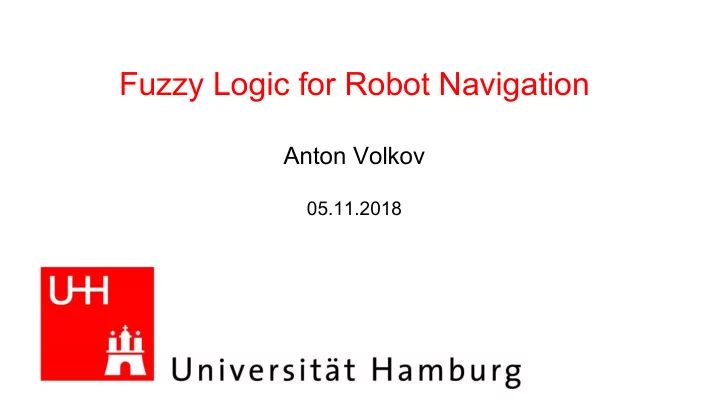

Fuzzy Logic for Robot Navigation Anton Volkov 05.11.2018 http://www.informatik.uni-hamburg.de/WTM/
Agenda ▪ Motivation ▪ Fuzzy logic introduction ▪ Fuzzy logic-based navigation ▪ Conclusion ▪ Discussion Anton Volkov Fuzzy Logic for Robot Navigation 2
Motivation ▪ Classical planning approaches are unable to cope with dynamic environment [1] ▪ Approach the problem of robot navigation in dynamic environment based on fuzzy logic ▪ Explore advantages and disadvantages of the given approach Anton Volkov Fuzzy Logic for Robot Navigation 3
Fuzzy logic introduction ▪ Fuzzy logic • Fuzzy set • Membership function • ... ▪ Fuzzy system design • Fuzzification / Defuzzification • Inference engine • ... Anton Volkov Fuzzy Logic for Robot Navigation 4
Fuzzy sets (U, m) | m : U ➝ [0, 1] U - universe of discourse m - membership function [http://cadia.ru.is] Anton Volkov Fuzzy Logic for Robot Navigation 5
Fuzzy sets (U, m) | m : U ➝ [0, 1] U - universe of discourse ~0.6 m - membership function ~0.25 LOW(x) ≈ 0.6 x MEDIUM(x) ≈ 0.25 [http://cadia.ru.is] HIGH(x) = 0 Anton Volkov Fuzzy Logic for Robot Navigation 6
Fuzzy systems Anton Volkov Fuzzy Logic for Robot Navigation 7
Fuzzifier real-value inputs x ↓ ↓ membership functions LOW(x), MEDIUM(x), HIGH(x) ↓ ↓ truth values 0.6, 0.25, 0 Anton Volkov Fuzzy Logic for Robot Navigation 8
Fuzzy Rule Base Set of “if-then” rules that define system reaction to input 1. if x is LOW then y = 1 2. if x is MEDIUM then y = 2 3. if x is HIGH then y = 3 Anton Volkov Fuzzy Logic for Robot Navigation 9
Fuzzy Inference Engine ▪ Contains rules to define “logic” in fuzzy logic • m(x ∨ y) = MAX(m(x), m(y)) • m(x ∧ y) = MIN(m(x), m(y)) • m( ¬ x) = 1 - m(x) ▪ Defines the relation between fuzzy input and fuzzy output Anton Volkov Fuzzy Logic for Robot Navigation 10
Defuzzifier Produces the output based on the most suitable rule 1. if x is LOW then y = 1 LOW(x) = 0.6 2. if x is MEDIUM then y = 2 MEDIUM(x) = 0.25 3. if x is HIGH then y = 3 HIGH(x) = 0 Anton Volkov Fuzzy Logic for Robot Navigation 11
Fuzzy system design for robot navigation Anton Volkov Fuzzy Logic for Robot Navigation 12
Example fuzzy system - outline Navigation = goal tracking + obstacle avoidance Assumptions: ▪ 2 driving wheels on the same axis ▪ Goal position is known ▪ Obstacle positions are not known Anton Volkov Fuzzy Logic for Robot Navigation 13
Example fuzzy system - goal tracking Anton Volkov Fuzzy Logic for Robot Navigation 14
Example fuzzy system - goal tracking [2] [2] Anton Volkov Fuzzy Logic for Robot Navigation 15
Example fuzzy system - goal tracking V L , V R = {Z, F, M, B, VB} [2] Anton Volkov Fuzzy Logic for Robot Navigation 16
Example fuzzy system - goal tracking [2] Notes: ■ output is discrete ■ path is not optimal [2] Anton Volkov Fuzzy Logic for Robot Navigation 17
Example fuzzy system - obstacle avoidance [2] Anton Volkov Fuzzy Logic for Robot Navigation 18
Example fuzzy system - obstacle avoidance [2] Anton Volkov Fuzzy Logic for Robot Navigation 19
Example fuzzy system - obstacle avoidance Rule base consists of 62 rules (Takagi-Sugeno fuzzy inference [3]) Example: ■ If (Distance is VS) and (Angle is NB) and (S 1 is F) and (S 2 is F) and (S 3 is F) and (S 4 is F) then ( 𝑊 𝑆 is B) ( 𝑊 𝑀 is Z) ■ If (Distance is VS) and (Angle is NM) and (S 1 is F) and (S 2 is F) and (S 3 is F) and (S 4 is F) then ( 𝑊 𝑆 is M) ( 𝑊 𝑀 is Z) Anton Volkov Fuzzy Logic for Robot Navigation 20
Example fuzzy system - obstacle avoidance [2] [2] Anton Volkov Fuzzy Logic for Robot Navigation 21
Conclusion ■ Pros ● Applicable for navigating in dynamic environments ● Computationally simple ■ Cons ● Outdated ● Without obstacles path is not optimal ● Relies on the set of predefined rules ● ... Anton Volkov Fuzzy Logic for Robot Navigation 22
Reference 1. Ellips Masehian and Davoud Sedighizadeh, "Classic and Heuristic Approaches in Robot Motion Planning - A Chronological Review," Proceedings of World Academy of Science, Engineering and Technology, Vol. 23, pp. 101-106, August 2007 2. Hajer Omrane, Mohamed SlimMasmoudi, and Mohamed Masmoudi “Fuzzy Logic Based Control for Autonomous Mobile Robot Navigation”, Computational Intelligence and Neuroscience, Volume 2016, Article ID 9548482, August 2016 3. Michio Sugeno and Geuntaek Kang, “Structure identification of fuzzy model”, Fuzzy Sets and Systems, Vol. 28, Issue 1, pp. 15-33, October 1988 Anton Volkov Fuzzy Logic for Robot Navigation 23
Recommend
More recommend